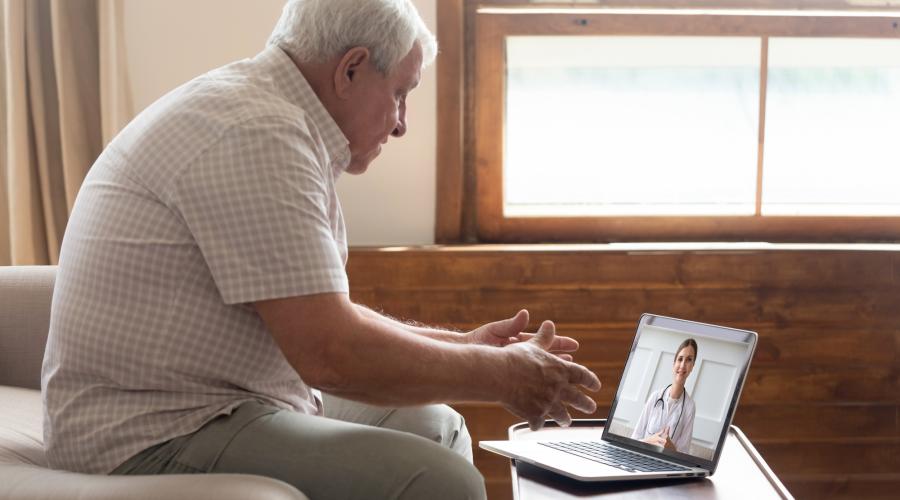
These days, there’s more ways than ever to stay connected with your doctor. By using virtual platforms to conduct doctor visits and checkups, you can gain valuable medical advice, right from your own home. Today, we’re discussing what telehealth is, how virtual doctor visits work, and how you should prepare for your next telehealth appointment.
What Is Telehealth And Telemedicine?
“Telehealth” is a broad, general term describing health care services delivered remotely or virtually. Telehealth can take many different shapes, and may include videoconferencing, text or chat platforms, or communicating with your doctor via a mobile health app or portal. Telemedicine is a bit more specific, and usually refers to clinical services that are delivered remotely, including diagnosis, monitoring, and management of various conditions.1
While telehealth and telemedicine have experienced a recent surge of popularity, the concept has been around since 1879, when physicians began using the telephone to reduce unnecessary patient visits.2 As technology has progressed, so have the capabilities of telehealth options. Now, telehealth allows patients to talk to their doctor on the go via text or email, receive remote patient monitoring, and virtually see a doctor via video calls.
What Is Cardiac Telemedicine?
Cardiac telehealth, or telecardiology, aims to reduce the barriers for people who want to stay on top of their heart health. As technological capabilities advance, more heart-related telehealth and telemedicine interventions are now available. Telecardiology visits are a great way to discuss any heart-related changes and concerns you may have. For people who are taking a statin, or just want to support their overall heart health, virtual visits can make asking your doctor about taking a heart healthy supplement like Ubiquinol CoQ10, easy and convenient.
Benefits Of Telehealth And Telemedicine
Telehealth and telemedicine offer a multitude of benefits to patients and doctors, including:
Expanding health services to more patients, especially those who need a specialist or live in remote areas
Cutting down patient costs, including travel time, parking, childcare, and taking time off work
Helping patients maintain appointment and care schedules
Decreasing rates of no-shows
Improving quality of care by allowing doctors to provide more consistent treatment
What’s Treatable Through Telehealth?
Telehealth can treat a wide array of health conditions. Since you won’t meet with the doctor in person, telehealth is best reserved for visits that don’t require detailed physical exams and in-office diagnostic tests. With this in mind, telehealth can be a great option for behavioral health, mental health, or follow up visits.3
How Do Virtual Doctor Visits Work?
Depending on your doctor and the technology they use, your virtual doctor visit may look different. In general, you’ll need to reach out to your doctor’s office or insurance company to learn whether telehealth appointments are available, and if so, how to schedule an appointment. When scheduling, you’ll typically need to provide some information and answer a few medical questions. If your condition is approved for a telehealth visit, you’ll be sent instructions on starting your virtual visit.
During a video conference visit, you’ll be able to see and hear your doctor, and vice versa. You’ll be able to explain your symptoms and show any physical concerns via the webcam or the platform’s photo sharing capabilities. Depending on your situation, your doctor will either provide a course of action or recommend an in-person visit to complete any necessary diagnostic tests or physical examinations.
READ MORE: How To Buy Ubiquinol Online
How To Prepare For A Telehealth Appointment
Once you’ve scheduled your virtual appointment, make sure you’re well-prepared for your visit by following these steps:
Check with your insurance: Insurance companies offer varying coverage for virtual visits, so be sure to check with your insurance company about coverage and copays.
Write down your symptoms: Telehealth visits are most effective when you can provide as much information as possible, so make a list of your symptoms and how long you’ve been experiencing each one. Be as thorough as possible - having a list to refer back to can prevent you from forgetting important details or questions.
Take a photo of symptoms: If you have an obvious physical issue, like a mole, bite, rash, or other visible ailment, take a photo and send it to your doctor.
Test your technology: Download any required apps or software before your visit and try logging in and setting up your account. Once you get everything working, be sure to fully charge your device in preparation of your appointment.
Find a quiet space: The last thing you want is your appointment being interrupted by your pets, family members, or other distractions. Find a quiet spot for your appointment where you can completely focus on the visit.
Be prepared for an in-person follow up: Telehealth is a great solution for many issues, but sometimes, there’s no getting around an in-person visit. If your doctor recommends an in-office visit, or asks you to seek emergency services from your local hospital or urgent care center, bring your notes from your telehealth appointment. Use them to recount your symptoms or provide any information you received during the telehealth visit.
Telehealth has many benefits, and by using virtual visits to enhance your health care services, you can connect with your doctor more often. With the right preparation, telehealth can help you take control of your health and learn more about living a healthy lifestyle.












